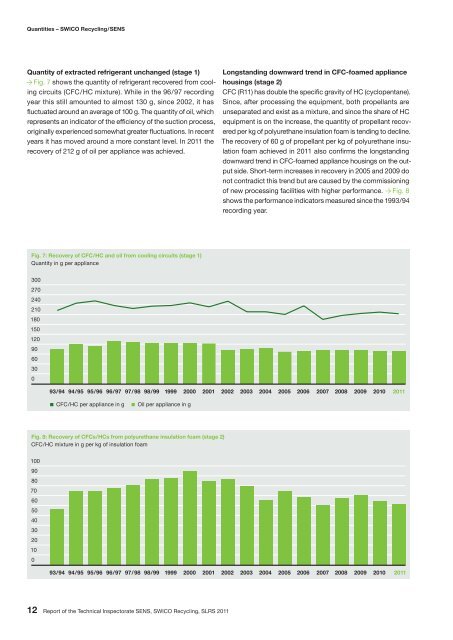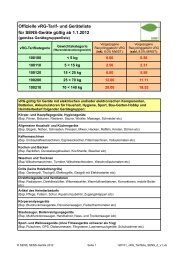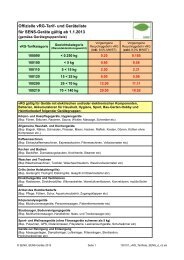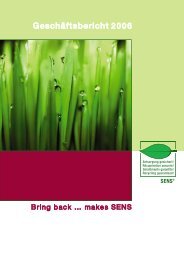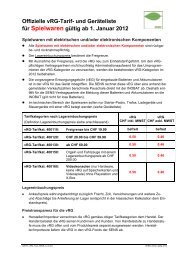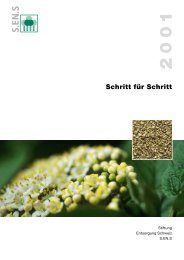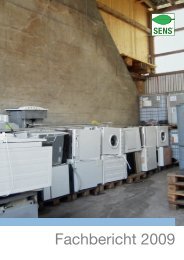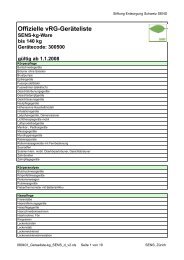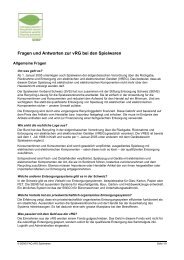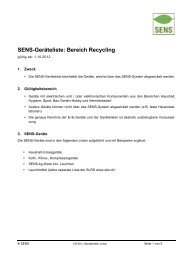Report of the Technical Inspectorate SENS, SWICO Recycling, SLRS
Report of the Technical Inspectorate SENS, SWICO Recycling, SLRS
Report of the Technical Inspectorate SENS, SWICO Recycling, SLRS
Create successful ePaper yourself
Turn your PDF publications into a flip-book with our unique Google optimized e-Paper software.
Quantities – <strong>SWICO</strong> <strong>Recycling</strong> / <strong>SENS</strong><br />
Quantity <strong>of</strong> extracted refrigerant unchanged (stage 1)<br />
� Fig. 7 shows <strong>the</strong> quantity <strong>of</strong> refrigerant recovered from cooling<br />
circuits (CFC / HC mixture). While in <strong>the</strong> 96 / 97 recording<br />
year this still amounted to almost 130 g, since 2002, it has<br />
fluctuated around an average <strong>of</strong> 100 g. The quantity <strong>of</strong> oil, which<br />
represents an indicator <strong>of</strong> <strong>the</strong> efficiency <strong>of</strong> <strong>the</strong> suction process,<br />
originally experienced somewhat greater fluctuations. In recent<br />
years it has moved around a more constant level. In 2011 <strong>the</strong><br />
recovery <strong>of</strong> 212 g <strong>of</strong> oil per appliance was achieved.<br />
Fig. 7: Recovery <strong>of</strong> CFC / HC and oil from cooling circuits (stage 1)<br />
Quantity in g per appliance<br />
300<br />
270<br />
240<br />
210<br />
180<br />
150<br />
120<br />
90<br />
60<br />
30<br />
0<br />
CFC / HC per appliance in g Oil per appliance in g<br />
12 <strong>Report</strong> <strong>of</strong> <strong>the</strong> <strong>Technical</strong> <strong>Inspectorate</strong> <strong>SENS</strong>, <strong>SWICO</strong> <strong>Recycling</strong>, <strong>SLRS</strong> 2011<br />
Longstanding downward trend in CFC-foamed appliance<br />
housings (stage 2)<br />
CFC (R11) has double <strong>the</strong> specific gravity <strong>of</strong> HC (cyclopentane).<br />
Since, after processing <strong>the</strong> equipment, both propellants are<br />
unseparated and exist as a mixture, and since <strong>the</strong> share <strong>of</strong> HC<br />
equipment is on <strong>the</strong> increase, <strong>the</strong> quantity <strong>of</strong> propellant recovered<br />
per kg <strong>of</strong> polyurethane insulation foam is tending to decline.<br />
The recovery <strong>of</strong> 60 g <strong>of</strong> propellant per kg <strong>of</strong> polyurethane insulation<br />
foam achieved in 2011 also confirms <strong>the</strong> longstanding<br />
downward trend in CFC-foamed appliance housings on <strong>the</strong> output<br />
side. Short-term increases in recovery in 2005 and 2009 do<br />
not contradict this trend but are caused by <strong>the</strong> commissioning<br />
<strong>of</strong> new processing facilities with higher performance. � Fig. 8<br />
shows <strong>the</strong> performance indicators measured since <strong>the</strong> 1993 / 94<br />
recording year.<br />
93 / 94 94 / 95 95 / 96 96 / 97 97 / 98 98 / 99 1999 2000 2001 2002 2003 2004 2005 2006 2007 2008 2009 2010 2011<br />
Fig. 8: Recovery <strong>of</strong> CFCs / HCs from polyurethane insulation foam (stage 2)<br />
CFC / HC mixture in g per kg <strong>of</strong> insulation foam<br />
100<br />
90<br />
80<br />
70<br />
60<br />
50<br />
40<br />
30<br />
20<br />
10<br />
0<br />
93 / 94 94 / 95 95 / 96 96 / 97 97 / 98 98 / 99 1999 2000 2001 2002 2003 2004 2005 2006 2007 2008 2009 2010 2011


